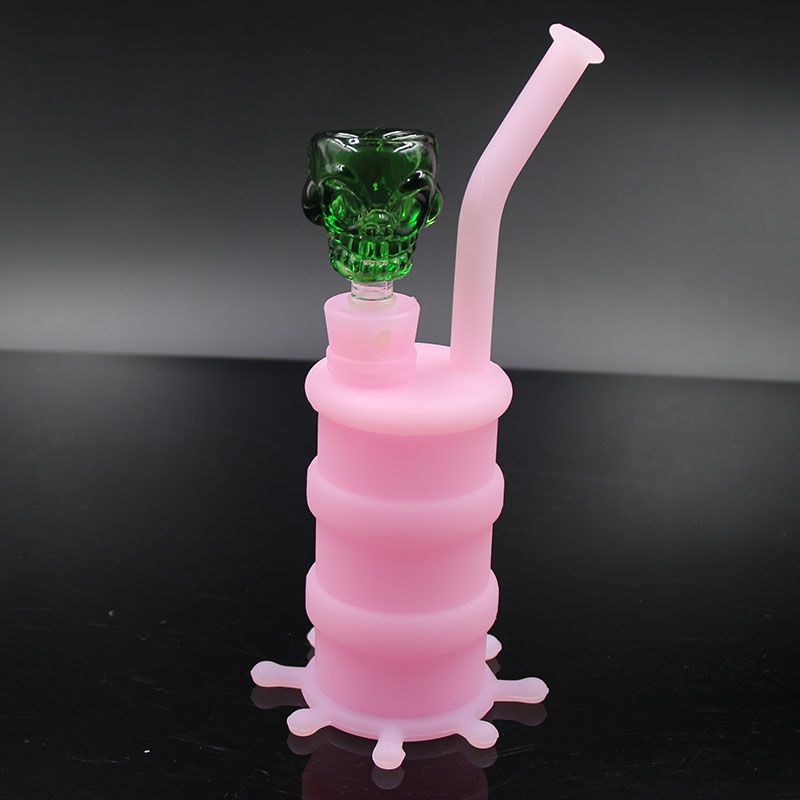Silicone bongs have emerged as a popular alternative to traditional glass water pipes, offering distinct advantages in durability, portability, and affordability. However, they also come with trade-offs in terms of flavor purity and long-term safety. This article explores the mechanics, pros, cons, and practical applications of silicone bongs, synthesizing insights from multiple expert sources[1][2][3][4][5].

Silicone bongs are crafted from BPA-free, food-grade silicone, ensuring heat resistance and flexibility. Unlike glass bongs, which use borosilicate glass, silicone bongs are molded into collapsible, unbreakable architectures designed for travel[2][3]. Their porous material allows compatibility with standard glass bowls and downstems, adding versatility to customization[4].
A standout feature of silicone bongs is their near-indestructibility. The flexible silicone withstands impacts, accidental drops, and extreme temperatures without cracking or shattering[1][3]. This makes them ideal for outdoor use, travel, or environments where glass bongs risk breakage[3][5].
Suited for on-the-go sessions, silicone bongs fold easily into backpacks or pockets, eliminating concerns about fragility. Collapsible designs retain functionality while minimizing storage space—unlike rigid glass alternatives[3][4]. Cleaning remains straightforward, as many models are dishwasher-safe, simplifying maintenance during travel[3][5].
Silicone bongs are significantly cheaper than glass equivalents, making them accessible for budget-conscious users. Premium glass bongs often surpass $50, whereas silicone options frequently retail under $30[1][4]. This affordability attracts those seeking a practical, low-risk investment for occasional use[1][5].
While high-quality silicone bongs use food-grade materials, cheaper alternatives risk leaching toxic chemicals when heated[3][5]. Users must prioritize food-grade silicone to avoid vaporizing harmful fumes. Regular replacement and thorough cleaning are recommended to mitigate risks of material degradation[3][4].
Silicone’s porous nature can impart subtle flavors or retain odors, contrasting with glass’s inert properties[2][3]. Users prioritize flavor purity may prefer glass, but silicone bongs maintain consistency across sessions with proper maintenance[2][5].
| Feature | Silicone Bongsmiş | Glass Bongsish |
|-----------------------|--------------------------------------|-----------------------------------|
| Durability | Nearly unbreakable[1][3] | Fragile (eleven laboratories glass)[3][5] |
| Cost | Affordable[1][4] | Higher premium[1][4] |
| Portability | Excellent[3][4] | Limited[3][5] |
| Flavor Purity | May absorb odors[2][3] | No modification of taste[2][5] |
Silicone’s non-stick surface eases residue removal, often requiring only simple rinsing or dishwasher cycles[3][4]. However, deep grooves can trap debris, necessitating occasional disassembly for thorough cleaning[3][5].
The material’s flexibility enables imaginative shapes, such as collapsible models or quirky designs (e.g., gas mask bongs)[4]. This contrasts with glass’s smooth, traditional aesthetic, appealing to users seeking novelty in their smoking accessories[4].
Their ruggedness makes them ideal for camping, festivals, or sports trips—rigorous environments where glass bongs’ fragility poses risks[2][3]. Quick assembly/disassembly and lightweight construction further enhance utility in dynamic settings[3][4
>
>
>Social Perception and Aesthetic Choices
FAQs About Silicone Bongs
Are silicone bongs safe to use?
Do silicone bongs affect flavor quality?
Why choose silicone over glass bongs?
How long does a silicone bong typically last?

Silicone Bongs: Overview of Material and Design
Silicone bongs are crafted from BPA-free, food-grade silicone, ensuring heat resistance and flexibility. Unlike glass bongs, which use borosilicate glass, silicone bongs are molded into collapsible, unbreakable architectures designed for travel[2][3]. Their porous material allows compatibility with standard glass bowls and downstems, adding versatility to customization[4].
Silicone Bong Durability: Key Advantage Over Glass
A standout feature of silicone bongs is their near-indestructibility. The flexible silicone withstands impacts, accidental drops, and extreme temperatures without cracking or shattering[1][3]. This makes them ideal for outdoor use, travel, or environments where glass bongs risk breakage[3][5].
Silicone Bongs for Portable Smoking Experiences
Suited for on-the-go sessions, silicone bongs fold easily into backpacks or pockets, eliminating concerns about fragility. Collapsible designs retain functionality while minimizing storage space—unlike rigid glass alternatives[3][4]. Cleaning remains straightforward, as many models are dishwasher-safe, simplifying maintenance during travel[3][5].
Cost Benefits of Silicone Bongs
Silicone bongs are significantly cheaper than glass equivalents, making them accessible for budget-conscious users. Premium glass bongs often surpass $50, whereas silicone options frequently retail under $30[1][4]. This affordability attracts those seeking a practical, low-risk investment for occasional use[1][5].
Decoding Silicone Bong Safety and Health Concerns
While high-quality silicone bongs use food-grade materials, cheaper alternatives risk leaching toxic chemicals when heated[3][5]. Users must prioritize food-grade silicone to avoid vaporizing harmful fumes. Regular replacement and thorough cleaning are recommended to mitigate risks of material degradation[3][4].
Impact on Flavor and Odor
Silicone’s porous nature can impart subtle flavors or retain odors, contrasting with glass’s inert properties[2][3]. Users prioritize flavor purity may prefer glass, but silicone bongs maintain consistency across sessions with proper maintenance[2][5].
Silicone Bongs vs. Glass Sp Innovation Comparisons
| Feature | Silicone Bongsmiş | Glass Bongsish |
|-----------------------|--------------------------------------|-----------------------------------|
| Durability | Nearly unbreakable[1][3] | Fragile (eleven laboratories glass)[3][5] |
| Cost | Affordable[1][4] | Higher premium[1][4] |
| Portability | Excellent[3][4] | Limited[3][5] |
| Flavor Purity | May absorb odors[2][3] | No modification of taste[2][5] |
Silicone Bong Maintenance and Cleaning
Silicone’s non-stick surface eases residue removal, often requiring only simple rinsing or dishwasher cycles[3][4]. However, deep grooves can trap debris, necessitating occasional disassembly for thorough cleaning[3][5].
Design Versatility in Silicone Bongs
The material’s flexibility enables imaginative shapes, such as collapsible models or quirky designs (e.g., gas mask bongs)[4]. This contrasts with glass’s smooth, traditional aesthetic, appealing to users seeking novelty in their smoking accessories[4].
Silicone Bongs for Outdoor and Active Lifestyles
Their ruggedness makes them ideal for camping, festivals, or sports trips—rigorous environments where glass bongs’ fragility poses risks[2][3]. Quick assembly/disassembly and lightweight construction further enhance utility in dynamic settings[3][4
>
>
>
